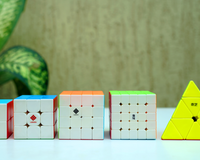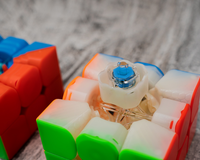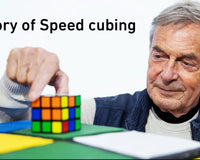Introduction
The Rubik’s Cube has taken countless forms and undergone numerous architectural changes since its invention in 1974. The cube's architecture greatly influences the user experience regarding speed, reliability, and overall performance. In recent years, two prominent methods of Rubik's Cube core design have emerged: the traditional spring-loaded mechanism and the revolutionary magnetic levitation or 'Maglev' system.
Let’s compare!

In the traditional spring-loaded Rubik's cube, the spring mechanism provides tension that holds the cube pieces together while still allowing them to rotate. This tension can be adjusted to the user's preference, influencing the cube's stability and turn speed. Spring-based cubes have been around for a long time, being used to break many world records, and are still being used by a lot of world-class speedcubers!
However, spring-loaded mechanisms are not without their shortcomings. Over time, the springs can wear out, causing uneven tension and degrading the overall cubing experience. Springs can also cause friction, which affects the cube's smoothness and speed, while also sometimes making an irritating spring noise. Furthermore, maintaining a spring-loaded cube requires regular lubrication, adding another layer of complexity to the mix.
On the other hand, the more recent Maglev system replaces the springs with opposing magnets. In this setup, the magnets mimic the role of springs, but with magnetic repulsion instead of mechanical tension. This approach to Rubik's cube architecture promises some distinct advantages over its spring-based predecessor.

One of the most immediate benefits of the Maglev system is its frictionless design. Because the pieces levitate due to the magnetic force, the friction typically encountered in spring-based cubes is virtually eliminated. This results in a smoother, faster rotation that many speed-cubers find appealing.
In terms of longevity, Maglev cubes also hold a substantial edge. There are no springs to wear out, which means the cube’s performance should remain consistent over a much more extended period of use. This reliability, coupled with the system's inherent lack of friction, means Maglev cubes require less maintenance and no regular lubrication, an advantage that many users appreciate.
Yet, Maglev cubes are not flawless. For one, they often have a noticeably different feel compared to traditional cubes. This change in experience might be off-putting to some cubers who are accustomed to a spring-loaded mechanism. Furthermore, Maglev cubes tend to be more expensive than their spring-loaded counterparts.
So, which is better? As with many things, it comes down to personal preference. Spring-loaded cubes offer a tried-and-true system. They are typically more affordable and provide a user experience that many consider more controllable.
Conversely, Maglev cubes offer a more high-tech twist to the core, with smoother rotations and lower maintenance. The lack of friction and mechanical wear may appeal to those prioritizing speed and longevity, provided they're willing to adjust to a different feel and potentially a higher cost.
Conclusion

In conclusion, the future of Rubik's cube architecture is not static. 7-8 years ago, we were introduced to magnets inside a cube and now, innovations such as the Maglev system are changing the world of speedcubing. Yet, traditional spring-based cubes continue to hold their own. Regardless of preference, the development and evolution of this amazing puzzle’s design are certain to keep it fresh, challenging, and relevant for many more years to come.
About Author

Sarthak Masta
Sarthak Masta is a speedcuber from Raipur. He started cubing in 2013 and now has 9 years of cubing experience. Apart from cubing, Sarthak enjoys making music and singing. He has attended a total of 7 competitions in Raipur and has gotten 10 podiums, with 2 gold medals, 4 silver medals and 4 bronze medals.






























